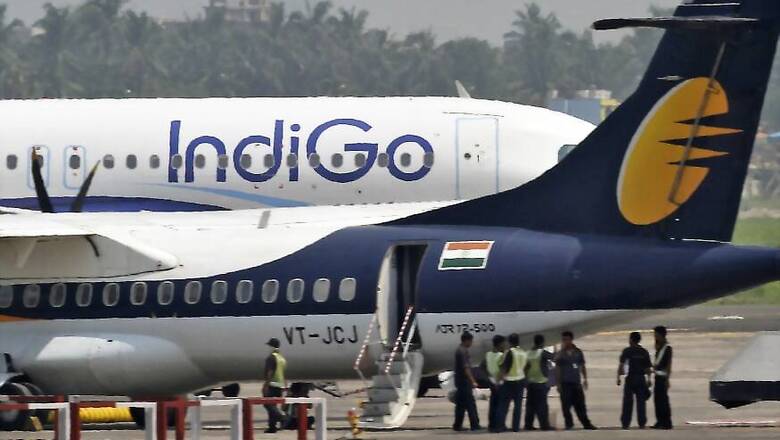
views
India probably retained the tag of the fastest-growing aviation market in 2018 as well, as the country added almost 22 million domestic fliers to take the total number of people in the skies last year at 138.97 million (117.16 million). That’s a jump of 18.6%, as per latest data by India’s aviation regulator, DGCA.
In fact, the growth in domestic aviation was a robust 18.86% between April-March 2017-18 and 21.77% in the same 12 months of 2016-17. It is evident that the Indian market has been witnessing unprecedented growth since at least 2016, but the same cannot be said of its airlines and their profitability. Booming passenger numbers have not been converted into profits by India’s airlines.
Any correlation between high passenger growth bringing in profits has been negated, as a high-cost and intensely competitive environment meant almost all domestic airlines are finding it tough to make money as fares remain ridiculously low and costs continue to surge. A surge in crude oil prices for much of 2018 hurt airline bottom-lines further and the three listed airlines had posted a combined loss of Rs 2,340 in one quarter (July-September 2018) alone.
A piece in the Mint newspaper says that the December quarter results of the three listed airlines — IndiGo, SpiceJet and Jet — are expected to show a decline in that combined loss number on improved fares and declining hike in fuel costs, but loss never-the-less remains.
In India, like elsewhere, the LCCs — airlines which have low cost models —have managed to fare better than the full service airlines almost always. In 2017, the LCCs held almost 60% of the market but by 2018, their share had gone up to 70%. Also, the FSCs — Air India, Vistara and Jet Airways — continue to bleed.
Not just high costs, aggressive capacity addition by IndiGo has also skewed the market dynamic. Among the FSCs, though none of the airlines is making money, Jet Airways is bleeding the most. Since last year, Jet has been facing trouble; the airline is in dire need of cash and nearing a shutdown. Its existing equity partner, Etihad Airways, is now in the fray along with some others to structure a deal where promoter Naresh Goyal will likely cede control of the airline he built from scratch as other investors come in.
Jet has been a significant player in the domestic market in India and its imminent downfall could cause severe turbulence — much like the demise of erstwhile Kingfisher Airlines did.
According to various media reports, the airline has funds to continue operations for just some more days.
So why is Jet floundering when the industry has been logging enviable growth and more and more people are taking to the skies? Well, for one, fares in India have remained at ridiculously low levels for months and on most occasions, the fare being charged does not even cover the cost of that seat! On top of this skewed pricing math, airlines continue to offer discounts and fire sales almost every second month in a bid to fill up planes. The FSCs are facing the worst end of the stick because to begin with, their costs are higher than the LCCs so they need to earn more per seat to break even and second, they are unable to match LCCs like IndiGo in capacity addition.
In calendar 2018, the DGCA data showed that except the small airlines (Vistara, AirAsia and GoAir), the only scheduled carrier which posted an increase in market share was IndiGo. IndiGo carried more than 11 million incremental passengers in 2018, the sharpest increase across the industry, cornering over 41% share of the market. Or every second incremental air passenger in India last year flew on an IndiGo flight as the airline added almost a fourth more capacity.
As for Jet, even though the number of passengers which flew this airline increased, the combined market share of Jet and JetLite fell in 2018. At the end of calendar 2017, Jet Airways held a market share of 15.4% and together with JetLite, this was 17.8%. This meant almost every sixth Indian flier chose a flight on the Jet group. The airline together carried 207.63 lakh passengers that year. But by the end of calendar 2018, its standalone market share had fallen to 13.8% and together with JetLite, it commanded 15.5% share of the market. The airline carried 214.65 lakh passengers which was a growth of just 3.4% — when the market was growing in high double digits.
Even Air India has failed to benefit from the passenger boom in India. Its market share fell from 13.3% in 2017 to 12.7% in 2018 though the number of passengers carried jumped by a little over two million.
In the new year, as Jet awaits a multi-agency rescue, Air India again gets government dole (in various forms including hiving off more than half the debt and loading it with more upfront equity), it is becoming increasingly clear that more passengers does not mean better profitability for Indian airlines. Unless the cost structures are reworked, fares revised and capacity addition plans updated in line with competition, more airlines than just Jet Airways could face turbulence.
(Author is a senior journalist. Views are personal)
















Comments
0 comment